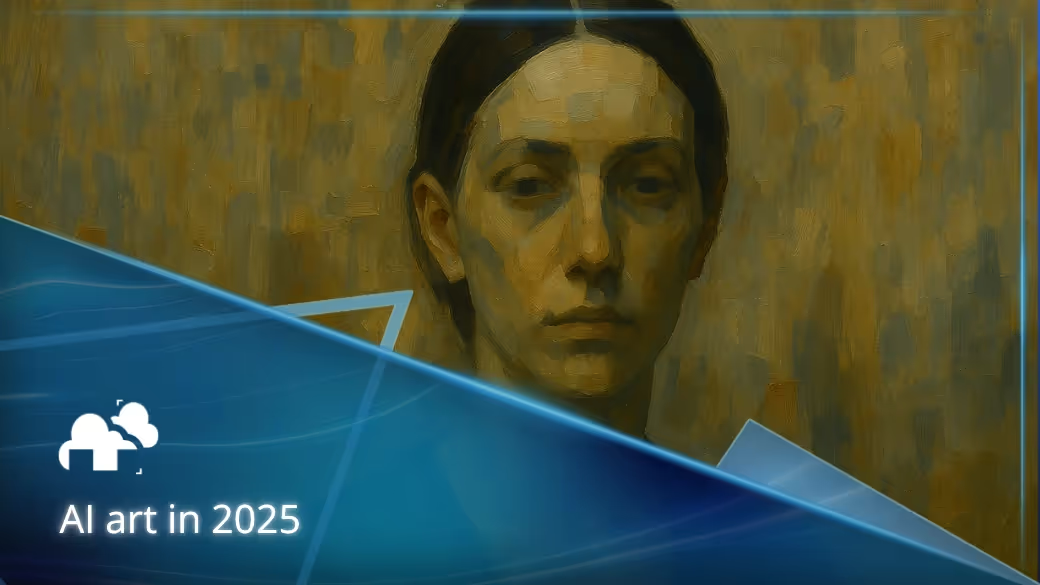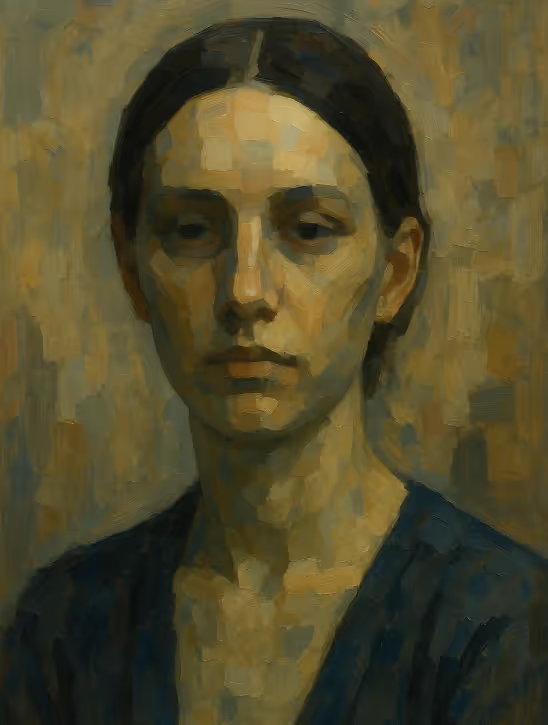
AI art has evolved from internet curiosity to a billion-dollar industry in a remarkably short time. However, while the market is booming, there’s a significant divide over whether AI art qualifies as "real" art. Artists are split where some see AI as a threat or even a disgrace to art, but with some seeing it as a valuable tool for creativity.
AI art, which utilizes machine learning models, is created by algorithms trained on vast datasets of existing artwork. This technology allows AI to generate highly convincing images and videos that are now becoming more and more indistinguishable from those created by human artists. However, the key difference lies in the creative process: AI lacks the innate human element of intention and emotion, which has fueled the debate surrounding the legitimacy of AI as an artistic medium.
The market for AI-generated art has exploded in recent years, with AI now expected to make up about 5% of the contemporary art market. 2024-2025 marked a breakthrough year for the technology, as it moved beyond experimental art and into mainstream acceptance. AI art also made a huge splash at Christie's auction house, which hosted its first all-AI auction in February 2025, grossing nearly $730,000.

While there are a variety of AI tools on the market, some stand out for their impressive capabilities. Midjourney, for example, leads the charge with a 26.8% market share due to its ability to create stunning illustrations and surreal artworks. Other tools, like DALL-E, are great for creating photorealistic images and are better at understanding prompts, while Stable Diffusion offers users greater control over the generated image, allowing them to tweak details to their liking. But despite the advancements in technology, AI-generated art still varies greatly in quality. The key difference often lies in the prompt engineering and how well trained the AI tool is. In this video by AnakinAI, we can also see a comparison between the different AI tools:
AI tools are rapidly transforming 3D pipelines by automating tasks like modeling, texturing, animation, and rendering. For example, tools like Meshy help generate 3D models with ready textures, be it realistic or stylized. Meanwhile, other tools like DeepMotion help in character animation using AI to capture and adjust human motion. However, while these tools offer significant improvements in efficiency, they still require an artist’s touch for the best results, as their effectiveness depends on proper integration with traditional workflows.
Although AI art is gaining ground, there is still skepticism surrounding AI’s role in the creative process. Many artists view AI as a threat to their careers and livelihoods, believing that the tools encourage laziness and erode the value of traditional artistic skills. But on the other hand, there are some artists who embrace AI as a collaborative tool, expanding their creative potential and offering new ways to remix and evolve artistic expression.
Some artists view AI as a tool for collaboration, not replacement. By leveraging AI's capabilities, they believe that their creativity becomes expanded and is no longer as limited. However, others feel that AI art disrespects the artistry and effort that goes into traditional art-making processes. The debate over whether AI is a complement to or a competitor for human artists remains a hot topic in creative communities.
A surprising study by Microsoft found that 38% of the time, people can’t tell AI-generated art from human-made art. The elements that give away AI art often include strange proportions and inconsistencies in textures or structures, though some of these imperfections are becoming less apparent as AI improves. AI usually has an uncanny vibe to it as well from being overly perfect. In some cases, AI renders can move unnaturally or have several mistakes that are easy to spot, and renders have been found to usually have a yellow tint to it (which tools like UnYellowGPT aim to solve).
As AI art grows in prominence, art experts face new challenges in authenticating pieces. There are concerns about the potential for fraud and the rise of counterfeit works, especially when a big majority of AI work are from other artists or companies who did not consent to their work to be used for training AI.
With no clear regulations or established methods for detecting AI art, experts are scrambling to develop tools that can differentiate human creations from machine-generated ones. Artists are also starting to use tools such as Glaze and Nightshade to mask their art to prevent it from being used to train AI. The legalities of AI in the art world (particularly regarding copyright) are still being defined, making this a complex issue for galleries, collectors, and artists alike.
As AI continues to automate parts of the creative pipeline, it’s important to understand that not everything in the 3D art process is up for replacement. Some aspects of 3D creation are simply too nuanced, too human, or too context-dependent for AI to fully take over (at least not anytime soon).
AI may be exceptional at generating models or mimicking visual styles, but it still struggles with things like intentional design choices, narrative consistency, and emotional storytelling, all of which make compelling 3D art. It demands artistic insight and understanding of context.
For example, concepting a world with a specific cultural tone or visual language goes beyond what a prompt can communicate to an AI. Artists rely on life experience, design literacy, and references that an AI might not even be aware of or take into consideration especially when those references aren’t present in its training data. There is also a strong possibility of wrong interpretations by the AI, making it harder for artists to really tweak and get the exact look they want.
With the rise of AI tools that can generate different things such as 3D models, one might think the job of a modeler is becoming obsolete. But in reality, AI-generated assets often come with flaws such as intersecting faces, poor topology, and terrible UV maps, to name a few. These issues need to be addressed before a model can be used in production, especially for animation or real-time rendering. This has created new roles for those who choose to adapt AI-generated assets such as specific mesh cleanup and topology correction done for those AI assets. While the roles have existed even before the rise of AI, it has become more apparent now with even some entire businesses centered around fixing AI.
In other words, not all roles are disappearing or will disappear, but they are changing. Instead of building everything from scratch, artists might now find themselves refining, optimizing, and creatively repurposing AI-generated outputs.
What we're seeing doesn’t need to be a total replacement, but more of redefinition and collaboration. AI is becoming another tool in the 3D artist’s toolkit that is powerful, but still dependent on human hands to use it well. Artists who learn to guide, curate, and elevate AI outputs will likely find themselves at an advantage.
Art pipelines may change, but it won't vanish. It will most likely evolve into a blend of automation and human craftsmanship, where knowing how to prompt a machine is just as valuable as knowing how to sculpt in ZBrush or animate in Maya.
AI learns how to create art by analyzing millions of existing images and artworks. The issue here is that many of these datasets contain copyrighted works that are used without the original artist's permission. As a result, artists are suing for compensation, arguing that their creations are being exploited by AI companies without their consent.
The question of whether AI-generated art can be considered "real" art has sparked major controversy. In a survey by KOAA, 76% of people do not consider AI-generated works to be real or “genuine” art. This divide touches on the very nature of creativity, with some seeing AI as a tool for copying existing ideas rather than generating original concepts. Meanwhile, protests from artists continue to challenge AI art’s legitimacy and its place in the art world.
As AI tools advance, their integration into art pipelines such as 3D and animation can create exciting opportunities. Rather than replacing human artists, AI can serve as a powerful collaborator that enhances productivity, creativity, and efficiency. Here’s how you can begin to incorporate AI into your workflow, from concept to final render.
AI excels at generating quick iterations of concept art, allowing artists to explore more ideas in less time. By using AI tools, concept artists can quickly generate mood boards, environment concepts, or character designs that serve as inspiration for further refinement. AI-generated concepts also allow teams to brainstorm multiple options before committing to a single direction, which can be especially helpful in the early stages of a project.Once the AI generates concepts, artists can refine and add their personal touch, ensuring that the vision remains grounded in the project’s aesthetic goals. They can then build on these concepts and bring it into production.
AI’s ability to generate 3D models has opened new possibilities for creating assets more quickly. Programs like Meshy, Rodin (Hyper3D), and Tripo enable artists to generate 3D assets by using textual prompts or image-based inputs. Artists can use AI-generated models as rough bases, and then tweak them to fit the project’s needs. This approach can potentially speed up the asset creation phase, most especially for background objects or low-priority elements in the scene. However, it is still important to note that AI generated models can still require significant cleanup and refinement, which might actually slow down the workflow depending on the amount of issues needed to fix. In this video by Stefan 3D AI Lab, you can get a look at the different 3D generators and see what could be the best one for you:
AI tools like Meshy and Scenario can assist in generating textures based on a few inputs, such as color, material type, or style. These tools can create procedural textures that adapt to the surface details of models automatically, or even generate a texture for a unique asset. Artists can use these AI-generated textures as a base and then fine-tune them, adding subtle variations or enhancing certain areas that require more attention.
The future of AI art promises even greater advances in technology. Expect to see better consistency and control over style, with real-time generation and editing becoming possible. AI tools are also likely to integrate more with virtual reality (VR) and interactive media, opening up new possibilities for immersive, dynamic art experiences.
Art institutions like The Getty are already incorporating AI art into their collections, and we may soon see AI artists recognized alongside their human counterparts in even bigger exhibitions. However, while the $40 billion by 2033 projection for AI art is exciting, the market's growth will depend on several factors, including regulation and the evolution of copyright laws.
The rise of AI art is a complex and multifaceted phenomenon. While the technology is undeniably impressive, its place in the art world remains a point of contention. Whether viewed as a tool for collaboration or a threat to artistic integrity, AI art is most likely here to stay, and its future is likely to be shaped by ongoing debates over creativity, ownership, and authenticity.